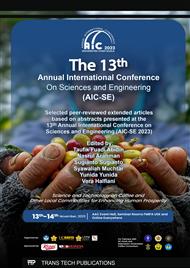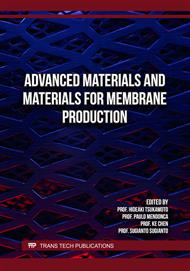[1]
A. Strzelewicz, M. Krasowska, G. Dudek, M. Ciesla, Design of Polymer Membrane Morphology with Prescribed Structure and Diffusion Properties, Chemical Physics 531, 2020, pp.1-7
DOI: 10.1016/j.chemphys.2019.110662
Google Scholar
[2]
E. H. Alosaimi, I. H. Alhosaimi, H. M. A. Hasan, Q. Chen, S. Melhi, and A. A. Younes, Towards superior permeability and antifouling performance of sulfonated polyethersulfone ultrafiltration membranes modified with sulfopropyl methacrylate functionalized SBA-15, Chinese Journal of Chemical Engineering, 2023, 53, pp.89-100.
DOI: 10.1016/j.cjche.2021.09.019
Google Scholar
[3]
J. Efendi, S. Aprilia, and F. M. Djuned, Preparation and Characterization of Fly Ash Additive-Modified Polyether-Based Membrane, Jurnal Rekayasa Kimia dan Lingkungan, 2023, 18, pp.93-99.
DOI: 10.23955/rkl.v18i2.26297
Google Scholar
[4]
S. Acarer, I. Pir, M. Tufekci, T.Erkoc, V. Oztekin, S. G. Durak, M. S. Ozcoban, G. T. Demirkol, M. Alhammod, S. Cavus, and N. Tufekci, Characterisation and modelling the mechanics of cellulose nanofibril added polyethersulfone ultrafiltration membranes, Heliyon, 2023, 9, e13086.
DOI: 10.1016/j.heliyon.2023.e13086
Google Scholar
[5]
S. Aprilia, W. Fuji, A. Nasrul, and R. Khairul, R, Removal of COD and BOD from Animals Slaughterhouse Waswater Through Polyethersulfone/Cellulose Nano Crystals Membrane, Materials Today: Proceedings, 2022, S101-S10.
DOI: 10.1016/j.matpr.2022.02.045
Google Scholar
[6]
S. Aprilia, C. M. Rosnelly, Zuhra, F. Fitriani, E.H. Akbar, M. Raqib, K. Rahmah, A. Amin, and R. A. Baity, Synthesis of Amorphous Silica from Rice Husk Ash Using the Sol–Gel Method: Effect of Alkaline and Alkaline Concentration, Materials Today: Proceedings, 2023, pp.225-229.
DOI: 10.1016/j.matpr.2023.02.403
Google Scholar
[7]
U. Fathanah, M. Izarul, M. Riza, N. Arahman, M. R. Lubis, and M. Yusuf, The Improvement of Hydrophilic Property of Polyethersulfone Membrane with Chitosan as Additive, Jurnal Rekayasa Kimia Lingkungan, 2019, 15(1), pp.53-61.
DOI: 10.23955/rkl.v15i1.15916
Google Scholar
[8]
J. Lin, W. Ye, K. Zhong, J. Shen, N. Jullok, A. Sotto, and B.V. Bruggen, Enhancement of Polyethersulfone (PES) Membrane Doped by Monodisperse Stober Silica for Water Treatment, Chemical Engineering and Processing, 2015, pp.194-205.
DOI: 10.1016/j.cep.2015.03.011
Google Scholar
[9]
V. R. Pereira, A. M. Isloor, Bhat, K. Udaya, and A. F. Ismail, Preparation and Antifouling Properties of PVDF Ultrafiltration Membranes With polyaniline (PANI) Nanofibers and Hydrolysed PSMA (H-PSMA) As Additives, Desalination, 2014, p.220–227
DOI: 10.1016/j.desal.2014.08.002
Google Scholar
[10]
S. Mulyati, F. Razi, and Zuhra, Characteristic of Polyethersulfone (PES) Asymmetric Membrane with Dimethyl Formamide and N-Methyl Pyrrolidone as Solvent, Biopropal Industri, 2017, 8(1), pp.55-62
Google Scholar
[11]
H. Susanto and M. Ulbricht, Characteristics, performance and stability of polyethersulfone ultrafiltration membranes prepared by phase separation method using different macromolecular additives, 2009, pp.125-135
DOI: 10.1016/j.memsci.2008.11.025
Google Scholar
[12]
E. Rahmah, N. A. Sunia, and J. Suhartono, Membran Polyethersulfone (PES)/CNT-TiO2 untuk Penyisihan Humic Acid di Bendungan Jatiluhur, Diseminasi FT, 2022, p.1‐8
Google Scholar
[13]
S. Muchtar, M. Y. Wahab, S. Mulyati, N. Arahman, and M. Riza, Superior fouling resistant PVDF membrane with enhanced filtration performance fabricated by combined blending and the self-polymerization approach of dopamine, Journal of Water Process Engineering, 2019, 28, pp.293-299.
DOI: 10.1016/j.jwpe.2019.02.012
Google Scholar
[14]
U. Fathanah, and H. Meilina, Karakterisasi dan Kinerja Membran Polyethersulfone Termodifikasi Aditif Anorganik secara Blending Polimer, Jurnal Serambi Engineering, 2021, 6(4).
DOI: 10.32672/jse.v6i4.3515
Google Scholar
[15]
D. Y. Koseoglu-Imer, The determination of performances of polysulfone (PS) ultrafiltration membranes fabricated at different evaporation temperatures for the pretreatment of textile wastewater, Desalination, 2013, 316, pp.110-119.
DOI: 10.1016/j.desal.2013.02.011
Google Scholar



